Beyond the sentence given
- PMID: 17412680
- PMCID: PMC2429998
- DOI: 10.1098/rstb.2007.2089
Beyond the sentence given
Abstract
A central and influential idea among researchers of language is that our language faculty is organized according to Fregean compositionality, which states that the meaning of an utterance is a function of the meaning of its parts and of the syntactic rules by which these parts are combined. Since the domain of syntactic rules is the sentence, the implication of this idea is that language interpretation takes place in a two-step fashion. First, the meaning of a sentence is computed. In a second step, the sentence meaning is integrated with information from prior discourse, world knowledge, information about the speaker and semantic information from extra-linguistic domains such as co-speech gestures or the visual world. Here, we present results from recordings of event-related brain potentials that are inconsistent with this classical two-step model of language interpretation. Our data support a one-step model in which knowledge about the context and the world, concomitant information from other modalities, and the speaker are brought to bear immediately, by the same fast-acting brain system that combines the meanings of individual words into a message-level representation. Underlying the one-step model is the immediacy assumption, according to which all available information will immediately be used to co-determine the interpretation of the speaker's message. Functional magnetic resonance imaging data that we collected indicate that Broca's area plays an important role in semantic unification. Language comprehension involves the rapid incorporation of information in a 'single unification space', coming from a broader range of cognitive domains than presupposed in the standard two-step model of interpretation.
Figures






Similar articles
-
Unification of speaker and meaning in language comprehension: an FMRI study.J Cogn Neurosci. 2009 Nov;21(11):2085-99. doi: 10.1162/jocn.2008.21161. J Cogn Neurosci. 2009. PMID: 19016606
-
On-line integration of semantic information from speech and gesture: insights from event-related brain potentials.J Cogn Neurosci. 2007 Apr;19(4):605-16. doi: 10.1162/jocn.2007.19.4.605. J Cogn Neurosci. 2007. PMID: 17381252
-
The neural integration of speaker and message.J Cogn Neurosci. 2008 Apr;20(4):580-91. doi: 10.1162/jocn.2008.20054. J Cogn Neurosci. 2008. PMID: 18052777
-
Neural mechanisms of language comprehension: challenges to syntax.Brain Res. 2007 May 18;1146:23-49. doi: 10.1016/j.brainres.2006.12.063. Epub 2006 Dec 23. Brain Res. 2007. PMID: 17400197 Review.
-
Lateralization of auditory language functions: a dynamic dual pathway model.Brain Lang. 2004 May;89(2):267-76. doi: 10.1016/S0093-934X(03)00351-1. Brain Lang. 2004. PMID: 15068909 Review.
Cited by
-
Quantifiers are incrementally interpreted in context, more than less.J Mem Lang. 2015 Aug 1;83:79-96. doi: 10.1016/j.jml.2015.03.010. J Mem Lang. 2015. PMID: 26005285 Free PMC article.
-
Associative processes in intuitive judgment.Trends Cogn Sci. 2010 Oct;14(10):435-40. doi: 10.1016/j.tics.2010.07.004. Epub 2010 Aug 7. Trends Cogn Sci. 2010. PMID: 20696611 Free PMC article.
-
Fine-grained time course of verb aspect processing.PLoS One. 2022 Feb 25;17(2):e0264132. doi: 10.1371/journal.pone.0264132. eCollection 2022. PLoS One. 2022. PMID: 35213616 Free PMC article.
-
Eye Movements Reveal Delayed Use of Construction-Based Pragmatic Information During Online Sentence Reading: A Case of Chinese Lian…dou Construction.Front Psychol. 2019 Oct 30;10:2211. doi: 10.3389/fpsyg.2019.02211. eCollection 2019. Front Psychol. 2019. PMID: 31749722 Free PMC article.
-
Behavioral and neurophysiological indices of the racial bias modulation after virtual embodiment in other-race body.iScience. 2023 Sep 28;26(10):108085. doi: 10.1016/j.isci.2023.108085. eCollection 2023 Oct 20. iScience. 2023. PMID: 37860769 Free PMC article.
References
-
- Altmann G.T.M. Oxford University Press; Oxford, UK: 1997. The ascent of Babel: an exploration of language, mind, and understanding.
-
- Altmann G.T.M, Kamide Y. Incremental interpretation at verbs: restricting the domain of subsequent reference. Cognition. 1999;73:247–264. doi:10.1016/S0010-0277(99)00059-1 - DOI - PubMed
-
- Baggio, G., Van Lambalgen, M. & Hagoort, P. In press. Language, linguistics and cognition. In Handbook of philosophy of linguistics (eds M. Stokhof & J. Groenendijk).
-
- Barrett S.E, Rugg M.D. Event-related potentials and the semantic matching of pictures. Brain Cogn. 1990;14:201–212. doi:10.1016/0278-2626(90)90029-N - DOI - PubMed
-
- Brown C, Hagoort P. The processing nature of the N400: evidence from masked priming. J. Cogn. Neurosci. 1993;5:34–44. - PubMed
Publication types
MeSH terms
LinkOut - more resources
Full Text Sources

